White Biotech Market Size
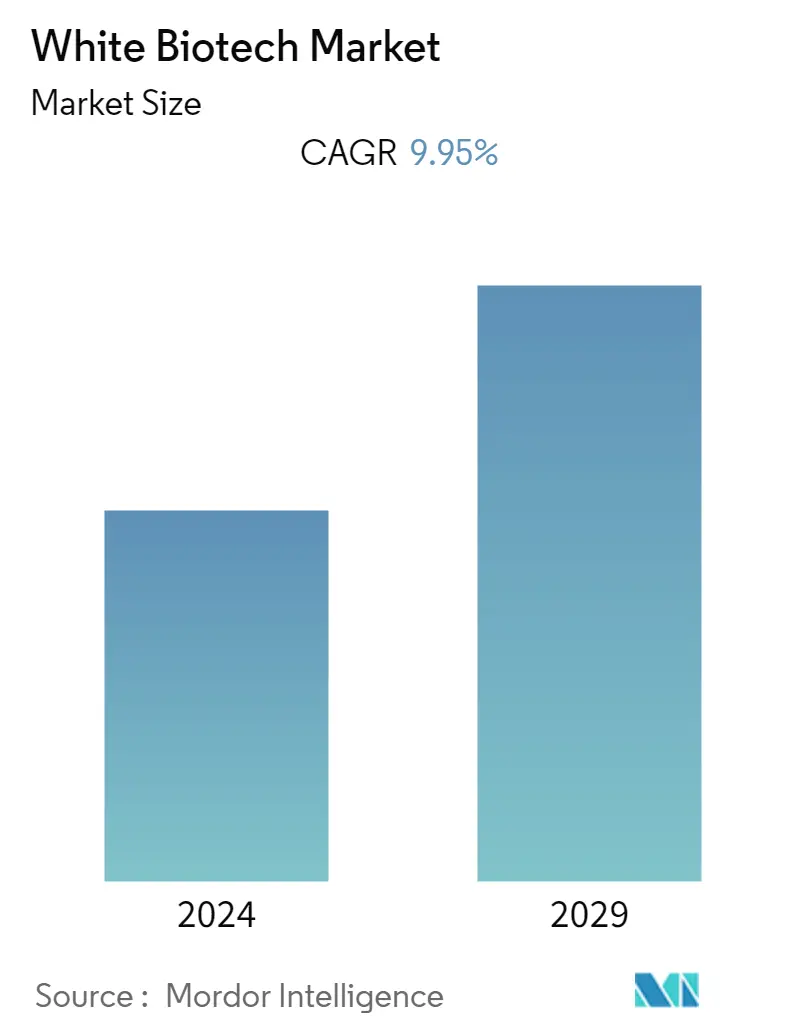
| Study Period | 2019 - 2029 |
| Base Year For Estimation | 2023 |
| CAGR | 9.95 % |
| Fastest Growing Market | Asia-Pacific |
| Largest Market | North America |
| Market Concentration | Low |
Major Players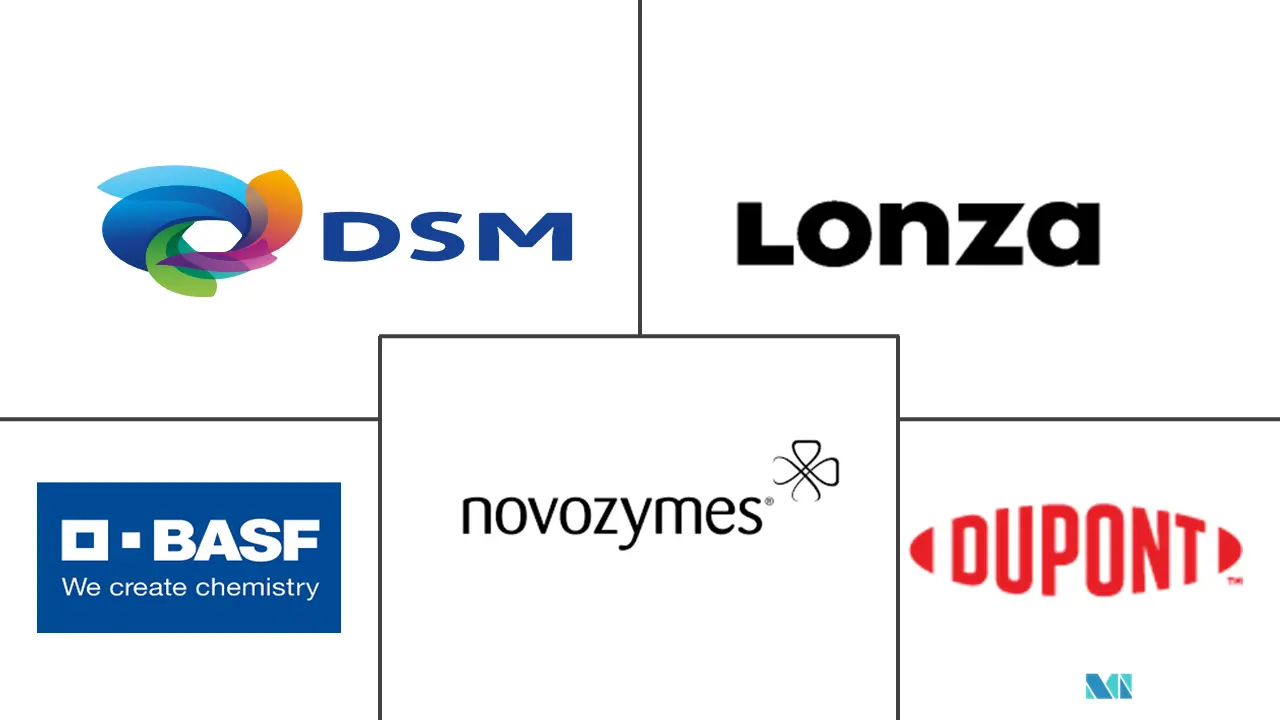
*Disclaimer: Major Players sorted in no particular order |
White Biotech Market Analysis
The white biotech market is currently valued at USD 315 billion and is projected to register a CAGR of 9.95% during the forecast period.
- White or industrial biotechnology is one of the most promising approaches to pollution prevention, resource conservation, and cost reduction, as it can reduce carbon dioxide emissions, energy consumption, and water consumption by 50%, 20%, and 75%, respectively. Moreover, as the fight against climate change becomes increasingly important, people worldwide are willing to pay more for sustainability.
- Consumers are increasingly making purchasing decisions based on environmental considerations and seeking products that use sustainable materials or processes with minimal adverse environmental effects. Such changes in purchase patterns encourage retailers and manufacturers to adopt white biotechnology to produce value-added chemicals from renewable sources.
- White biotechnology provides valuable components for the food, pharmaceutical, and agricultural sectors, as well as other industries. Many companies and brands are aware of the ongoing trend toward protecting the environment and are taking steps to promote sustainability. One such effort is that various consumers from industries, including automotive and consumer goods, focus on white biotechnology to meet sustainability targets and boost sales.
- Government bodies of several countries support emerging biofuel industries via subsidies, mandates, fuel tax adjustments, and incentives for using flex-fuel vehicles. For example, the United States, the European Union, Brazil, China, and others have started developing extra incentives for second-generation biofuels.
- Furthermore, in countries like India, the ban on single-use plastics and emphasis on utilizing recycled and reused materials to reduce dependency on fossil fuel sources, such as crude oil import, encourages companies to develop innovative eco-friendly packaging materials. Thus, such initiatives are accelerating the global white biotechnology market growth.
White Biotech Market Trends
Increasing Demand for Environmentally Friendly Products
- In recent years, consumers across the globe have become more conscious of the adverse environmental impacts of the products they buy and consume. For instance, according to a survey conducted by Hankook Ilbo in South Korea from May to June 2022 on the influence of environmentally friendly certificate marks attached to a product on purchasing decisions, more than 72 percent of surveyed consumers answered that such a label impacted their purchasing decisions.
- As a result, companies focus on improving the sustainability of their products and, consequently, the green credentials of their brands. This has further increased the demand for white biotechnology, which uses living cells from yeast, molds, bacteria, and plants, and enzymes to synthesize products that are easily degradable, require less energy, and create less waste during production.
- White biotechnology provides valuable components for food, pharmaceutical, agriculture, and other industries. The use of microbial-derived compounds ranges from obtaining compounds, such as flavorings, essential amino acids, polyunsaturated fatty acids, and organic acids, for the F&B industry to making fertilizers and biological pesticides for agriculture use. Also, microbes play a significant role in human health and well-being.
- Microbes produce primary metabolites such as vitamins, nucleotides, amino acids, and secondary metabolites. These secondary metabolites are used to make many drugs. Therefore, the vast applications of microbial-derived components and the increased demand for bio-based products are anticipated to influence the market positively in the coming years.
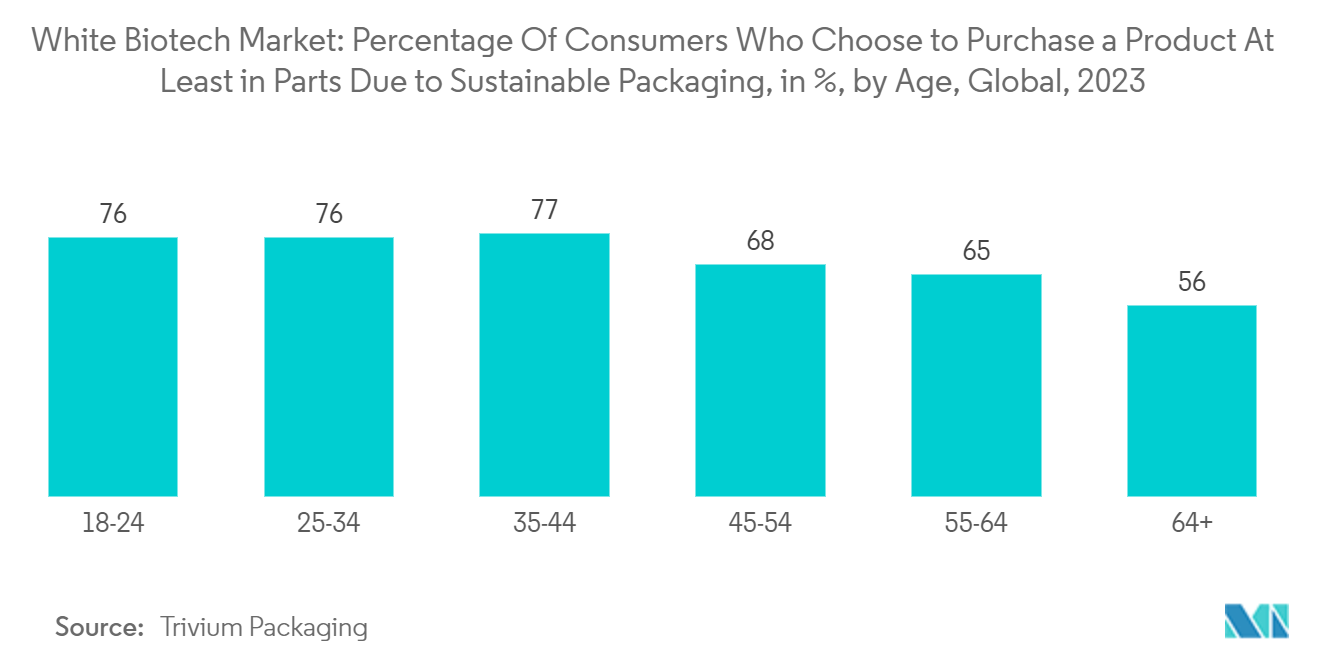
Asia-Pacific is the Fastest-growing Region in the White Biotech Market
- The biotech industry in the Asia-Pacific region has proliferated over the past decade due to the escalated demand for medical technologies, biologics, and biotechnologically altered food ingredients. The increasing production of bio-products acts as a key factor in bolstering the market growth in the region.
- As China prioritizes sustainability, environmental protection, and technological advancements, demand for white biotechnology will rise in various sectors to fulfill the need for sustainable solutions, energy security, improved healthcare, agricultural productivity, and waste management. Moreover, players strategically invest in local companies to expand their market share.
- For instance, in 2021, BASF Venture Capital (BVC) invested in Bota Biosciences Ltd (Bota Bio), an industrial synthetic biotech company located in Hangzhou, China, which develops next-generation biotechnology platforms, enabling sustainable and economical production of high-value products for a broad array of industrial applications, like sweeteners, vitamins, personal care, or crop protection products. Other than this, white biotech has paved great opportunity in Japan's functional food and beverage segment due to the increased consumer inclinational toward food products with high nutritional claims.
- Furthermore, investments from foreign companies in biotech startups in Australia due to the country's strong research capabilities, innovative ecosystem, and growth potential are expected to propel the market growth.
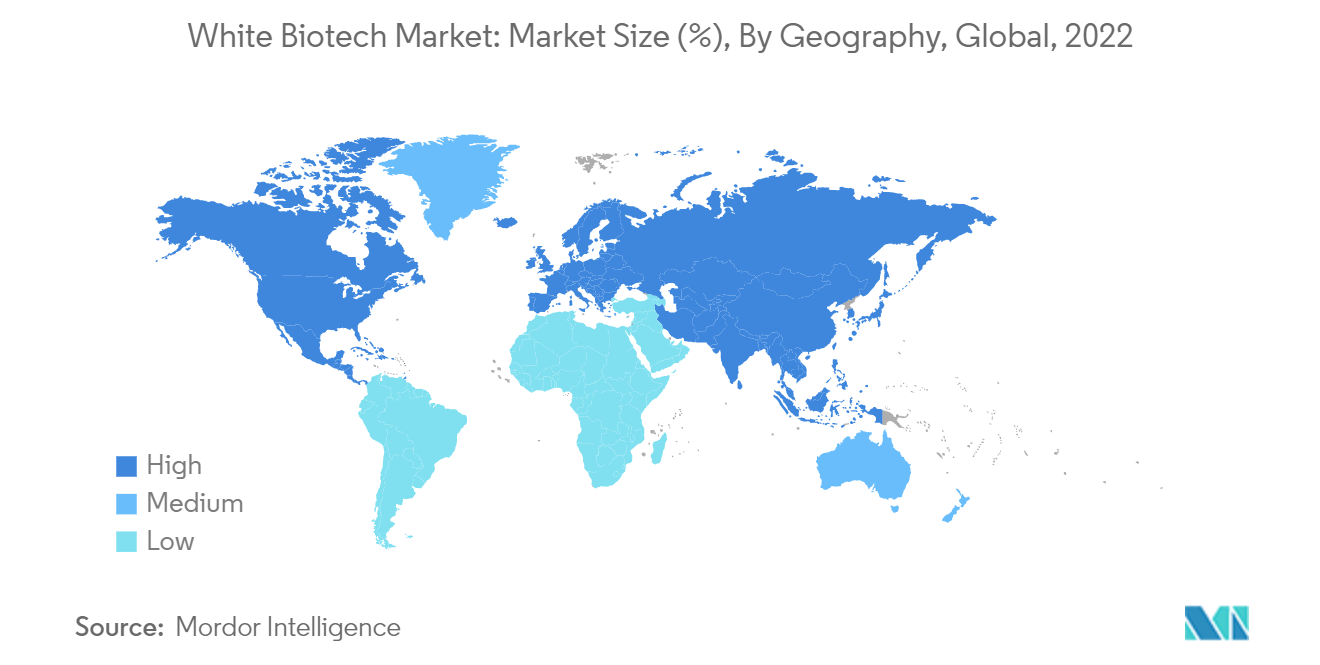
White Biotech Industry Overview
The white biotech market is highly competitive, with a strong presence of regional and global players. The market is driven by consumer awareness towards sustainability and efficient production of products. Thus, the players operating in the market are trying to position themselves according to the demographic group.
Some prominent players, like Dupont De Nemours, Inc., Novozymes A/S, Lonza Group Ltd, Koninklijke DSM NV, and BASF SE, have been focusing on developing new and innovative products by targeting the new formulation for the market and engineering the various unexplored microorganisms in the market.
White Biotech Market Leaders
-
Dupont De Nemours, Inc.
-
Novozymes A/S
-
Lonza Group Ltd
-
Koninklijke DSM NV
-
BASF SE
*Disclaimer: Major Players sorted in no particular order
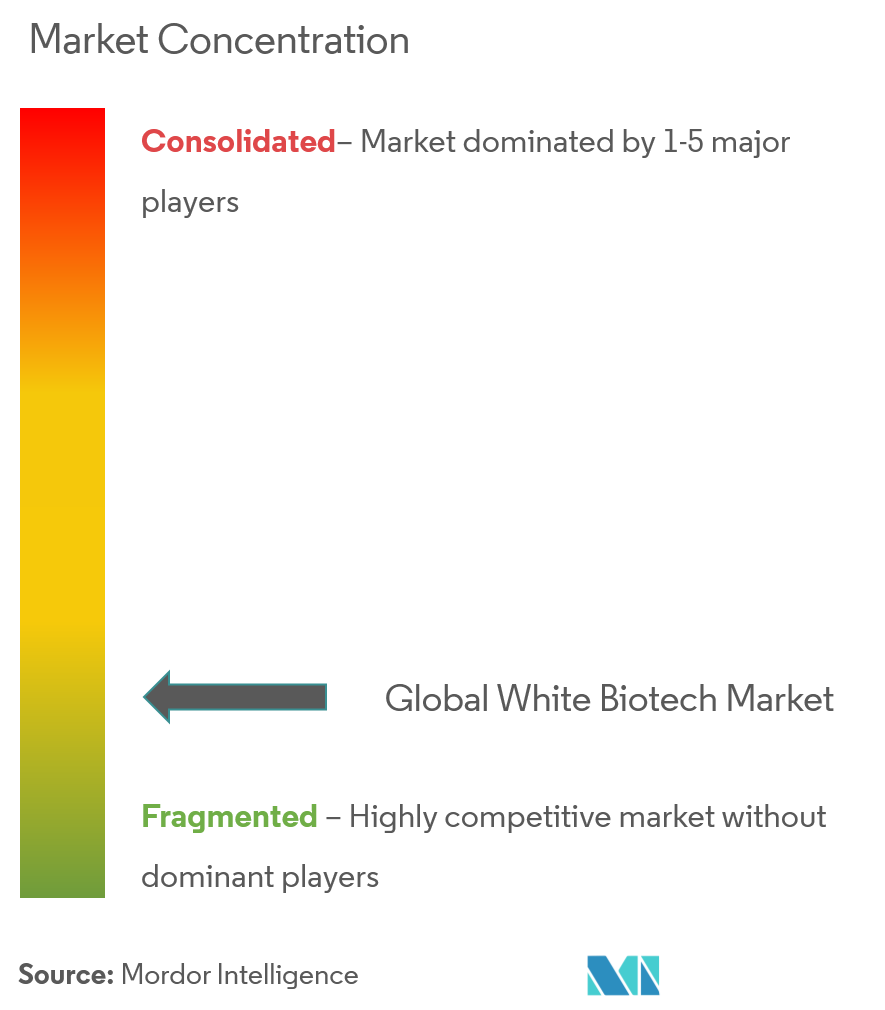
White Biotech Market News
- March 2023: Danisco Animal Nutrition launched AXTRA Prime, an optimized enzyme blend created to address significant changes in piglet production in the United States. The company claims that it enhances gut health, improves nutrient digestion, and produces measurable performances in swine.
- December 2021: BASF Venture Capital (BVC) made a strategic investment in Bota Biosciences Ltd (Bota Bio), an innovative industrial synthetic biotech company based in Hangzhou, China. Bota Bio specializes in developing cutting-edge biotechnology platforms that facilitate the sustainable and cost-effective production of high-value products for a wide range of industrial applications, including sweeteners, vitamins, personal care items, and crop protection products.
- June 2021: Eucodis expanded its CalBcollection with novel immobilized variants like EUCODIS CalB01 optimized for applications in organic solvents, EUCODIS CalB02 optimized for aqueous media, and EUCODIS wildtype-CalB.
White Biotech Market Report - Table of Contents
1. INTRODUCTION
- 1.1 Study Assumptions and Market Definition
- 1.2 Scope of the Study
2. RESEARCH METHODOLOGY
3. EXECUTIVE SUMMARY
4. MARKET DYNAMICS
-
4.1 Market Drivers
- 4.1.1 Increasing Consumer Demand for Products with Low Environmental Impacts
- 4.1.2 Dedicated Policies and Government Efforts to Promote the use of Biotechnology
-
4.2 Market Restraints
- 4.2.1 Deteriorating Fertility of Agricultural Lands
-
4.3 Porter's Five Forces Analysis
- 4.3.1 Threat of New Entrants
- 4.3.2 Bargaining Power of Buyers/Consumers
- 4.3.3 Bargaining Power of Suppliers
- 4.3.4 Threat of Substitute Products
- 4.3.5 Intensity of Competitive Rivalry
5. MARKET SEGMENTATION
-
5.1 By Type
- 5.1.1 Biofuels
- 5.1.2 Biomaterials
- 5.1.3 Biochemicals
- 5.1.4 Industrial Enzymes
-
5.2 By Application
- 5.2.1 Bioenergy
- 5.2.2 Pharmaceuticals
- 5.2.3 Food and Beverages
- 5.2.4 Feed
- 5.2.5 Other Applications
-
5.3 Geography
- 5.3.1 North America
- 5.3.1.1 United States
- 5.3.1.2 Canada
- 5.3.1.3 Mexico
- 5.3.1.4 Rest of North America
- 5.3.2 Europe
- 5.3.2.1 Germany
- 5.3.2.2 United Kingdom
- 5.3.2.3 France
- 5.3.2.4 Spain
- 5.3.2.5 Italy
- 5.3.2.6 Rest of Europe
- 5.3.3 Asia-Pacific
- 5.3.3.1 China
- 5.3.3.2 Japan
- 5.3.3.3 India
- 5.3.3.4 Australia
- 5.3.3.5 Rest of Asia-Pacific
- 5.3.4 South America
- 5.3.4.1 Brazil
- 5.3.4.2 Argentina
- 5.3.4.3 Rest of South America
- 5.3.5 Middle-East and Africa
- 5.3.5.1 South Africa
- 5.3.5.2 Saudi Arabia
- 5.3.5.3 Rest of Middle-East and Africa
6. COMPETITIVE LANDSCAPE
- 6.1 Strategies Adopted by Leading Players
- 6.2 Market Positioning Analysis
-
6.3 Company Profiles
- 6.3.1 EUCODIS Bioscience GmbH
- 6.3.2 Dupont De Nemours Inc.
- 6.3.3 Koninklijke DSM NV
- 6.3.4 BASF SE
- 6.3.5 Evonik Industries AG
- 6.3.6 Lonza Group Ltd
- 6.3.7 Laurus Labs
- 6.3.8 Corbion NV
- 6.3.9 Novozymes
- 6.3.10 Archer Daniels Midland Company
- *List Not Exhaustive
7. MARKET OPPORTUNITIES AND FUTURE TRENDS
** Subject To AvailablityWhite Biotech Industry Segmentation
White biotechnology, also known as industrial biotechnology, refers to the use of enzymes and microorganisms to produce bio-based products for use in sectors, such as chemicals, food and feed, healthcare, consumer goods, and automotive.
The white biotech market is segmented on the basis of type, application, and geography. Based on type, the white biotech market report is segmented into biofuels, biomaterials, biochemicals, and industrial enzymes. Based on application, the market report is segmented into bioenergy, pharmaceuticals, food and beverage, feed, and other applications. By geography, the market is segmented into North America, Europe, Asia-Pacific, South America, Middle East, and Africa.
The market sizing has been done in value terms in USD for all the above-mentioned segments.
| By Type | Biofuels | |
| Biomaterials | ||
| Biochemicals | ||
| Industrial Enzymes | ||
| By Application | Bioenergy | |
| Pharmaceuticals | ||
| Food and Beverages | ||
| Feed | ||
| Other Applications | ||
| Geography | North America | United States |
| Canada | ||
| Mexico | ||
| Rest of North America | ||
| Geography | Europe | Germany |
| United Kingdom | ||
| France | ||
| Spain | ||
| Italy | ||
| Rest of Europe | ||
| Geography | Asia-Pacific | China |
| Japan | ||
| India | ||
| Australia | ||
| Rest of Asia-Pacific | ||
| Geography | South America | Brazil |
| Argentina | ||
| Rest of South America | ||
| Geography | Middle-East and Africa | South Africa |
| Saudi Arabia | ||
| Rest of Middle-East and Africa |
White Biotech Market Research FAQs
What is the current White Biotech Market size?
The White Biotech Market is projected to register a CAGR of 9.95% during the forecast period (2024-2029)
Who are the key players in White Biotech Market?
Dupont De Nemours, Inc., Novozymes A/S, Lonza Group Ltd, Koninklijke DSM NV and BASF SE are the major companies operating in the White Biotech Market.
Which is the fastest growing region in White Biotech Market?
Asia-Pacific is estimated to grow at the highest CAGR over the forecast period (2024-2029).
Which region has the biggest share in White Biotech Market?
In 2024, the North America accounts for the largest market share in White Biotech Market.
What years does this White Biotech Market cover?
The report covers the White Biotech Market historical market size for years: 2019, 2020, 2021, 2022 and 2023. The report also forecasts the White Biotech Market size for years: 2024, 2025, 2026, 2027, 2028 and 2029.
White Biotechnology Industry Report
The Market Report Covers Global Biotech Companies and is Segmented by Type (Biofuels, Biomaterials, Biochemicals, and Industrial Enzymes), Application (Bioenergy, Pharmaceuticals, Food and Beverage, Feed, and Other Applications), and Geography (North America, Europe, Asia-Pacific, South America, and Middle-East and Africa). The market size is provided in terms of USD for all the above-mentioned segments. Statistics for the White Biotechnology market share, size and revenue growth rate, created by Mordor Intelligence™ Industry Reports. White Biotechnology analysis includes a market forecast outlook and historical overview. Get a sample of this industry analysis as a free report PDF download.
The global market is seeing significant growth due to increased demand in bioenergy and pharmaceuticals. This market report highlights the market trends and market growth driven by advancements in biotechnology. The industry report provides a comprehensive market analysis, including market segmentation and market value. The market research covers industry statistics and market data, offering insights into the market size and market share.
The industry analysis and market forecast include a detailed review of market leaders and their contributions to the market growth. The industry reports offer an industry overview and industry outlook, showcasing the market predictions and market review for the coming years. The report example and report PDF available for download provide in-depth industry information and industry trends.
Research companies focusing on white biotechnology are driving the industry sales and industry size, contributing to the market outlook and market overview. The market segmentation by type and application helps in understanding the market dynamics and market value. The industry research and market forecast highlight the potential market growth and market trends that are shaping the future of the white biotechnology sector.



